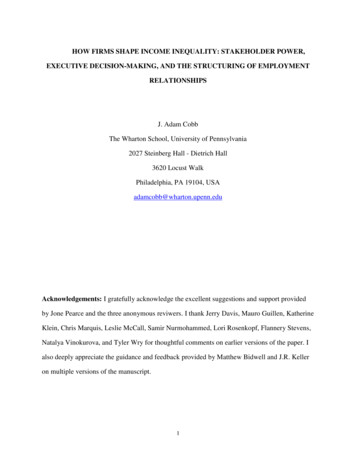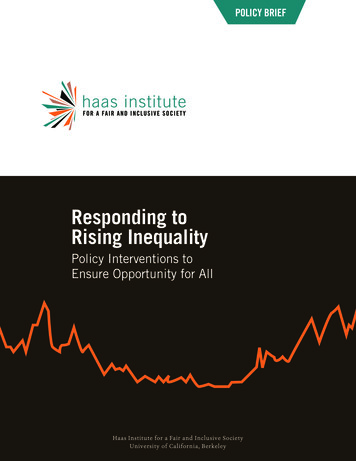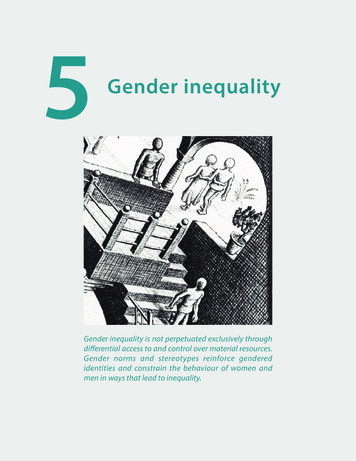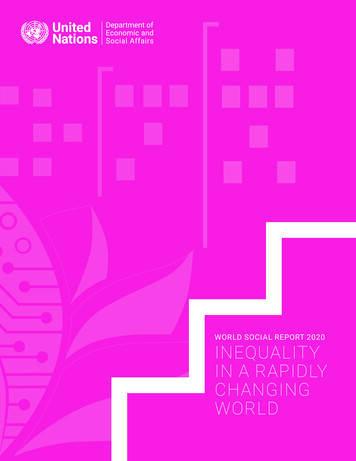
Transcription
HOW FIRMS SHAPE INCOME INEQUALITY: STAKEHOLDER POWER,EXECUTIVE DECISION-MAKING, AND THE STRUCTURING OF EMPLOYMENTRELATIONSHIPSJ. Adam CobbThe Wharton School, University of Pennsylvania2027 Steinberg Hall - Dietrich Hall3620 Locust WalkPhiladelphia, PA 19104, USAadamcobb@wharton.upenn.eduAcknowledgements: I gratefully acknowledge the excellent suggestions and support providedby Jone Pearce and the three anonymous reviwers. I thank Jerry Davis, Mauro Guillen, KatherineKlein, Chris Marquis, Leslie McCall, Samir Nurmohammed, Lori Rosenkopf, Flannery Stevens,Natalya Vinokurova, and Tyler Wry for thoughtful comments on earlier versions of the paper. Ialso deeply appreciate the guidance and feedback provided by Matthew Bidwell and J.R. Kelleron multiple versions of the manuscript.1
AbstractFocusing on developed countries, I present a model explaining how firms help determine rates ofincome inequality at the societal level. I propose that the manner in which firms rewardindividuals for their labor, match individuals to jobs, and where they place their boundariescontribute to levels of income stratification in a society. I argue the determinant of these threeprocesses is due, in part, to systems of corporate governance affecting the power and influence ofdifferent organizational stakeholders, resulting in variance in the types of employmentrelationships that predominate in a society. I conclude with a discussion of the researchimplications of emphasizing employers and employment practices as key determinants ofsocietal-level income inequality.Keywords: income inequality; employment relationship; internal labor markets; wage setting;job matching; firm boundaries; corporate governance; executive compensation2
Despite Plutarch's millennia-old warning that "an imbalance between rich and poor is themost fatal ailment of all republics," income inequality in the United States (US), which increased22.5 percent between 1980 and 2011, is now greater than at any point since the onset of the GreatDepression (Atkinson, Piketty, & Saez, 2011). Other industrialized nations also experiencedrising income inequality during this period, including Finland (17.8%), Germany (15.4%), Japan(20.6%), and the United Kingdom (UK) (32.9%), providing evidence of a broader, global trend.The implications of understanding this phenomenon are profound as a host of issues with greatrelevance, such as economic mobility, educational attainment, and life expectancies are found tobe related to income inequality (Stiglitz, 2012; Wilkinson & Pickett, 2009).Not surprisingly, scholars from across the social sciences have aimed to better understandthis phenomenon, typically advancing either market (e.g., skill-biased technological change,globalization) or institutional (e.g., unionization, minimum wages, and tax policy) explanationsfor its rise (Morris & Western, 1999). While providing many insights on the dynamics behindrising income inequality, these accounts leave significant variance unexplained. In particular, oneof the challenges of existing theories is that they are often not substantiated by cross-nationalanalyses (see DiPrete, 2007; Gottschalk & Smeeding, 1997; Heyes, Lewis, & Clark, 2012).Income inequality is a complex phenomenon with many factors likely playing a role in its rise,and as such, opportunities exist for developing new ideas that can explain cross-national rates ofincome inequality, complementing and extending our current perspectives of the phenomenon.Taking an initial step toward this end, I introduce a model that suggests a key factordetermining rates of income inequality at the societal level are employers’ actions regarding howthey structure employment relationships. Though not often considered in existing theories of thephenomenon, employers shape inequality by deciding how much to pay different workers indifferent jobs (Baron, 1984). Research has indicated that across developed countries, over thepast several decades, both within- (Lazear & Shaw, 2009) and between-firm (Faggio, Salvanes,3
& Van Reenen, 2010) income inequality has risen, and that much of that rise results from firmspaying otherwise equivalent workers differently (DiNardo, Fortin, & Lemieux, 1996; Groshen,1991). In fact, studies have suggested that nearly 40 percent of the total variation in wages acrosscountries emerges from similarly skilled workers being employed in firms that reward themdifferently (see Abowd & Kramarz, 1999). Because over 90 percent of the labor force indeveloped countries are employees of organizations (Marsden, 1999), research on incomeinequality can be importantly enhanced by taking into account decisions employers make abouthow to pay their workers, how they match workers to positions, and where employers place theirboundaries (i.e., how many workers do they employ). These considerations will help determinethe extent to which wages vary across different types of workers. How executives come to makedecisions about how to structure their firms’ employment relationships, I argue, is a consequenceof the power and interests of different organizational actors (March, 1962). I describe howcorporate governance mechanisms allocate power to various organizational stakeholders andhow these resulting power differentials affect the distribution of labor income in a societythrough the decisions executives make about how to structure their employment relationshipsNotwithstanding evidence suggesting employers play a significant role in determiningsocietal rates of income inequality, contemporary organizational scholarship has been mostlysilent about the phenomenon. A number of scholars have explored the consequences of wagedispersion at the intra-organizational level (for a review see Shaw, 2014) without much attentiongiven to where inequality emerges. While organizational research has long examinedemployment practices – such as wage setting (Balkin & Gomez-Mejia, 1990; Larkin, Pierce, &Gino, 2012), executive compensation (Wade, O'Reilly, & Pollock, 2006), outsourcing (DavisBlake & Broschak, 2009), and layoffs (Budros, 1997) – the distributional consequences of thesechanging practices to society has also been largely overlooked.4
Earlier conceptual work from the structuralist perspective did take seriously the role ofemployers in wage-setting outcomes. According to this view, organizations are a key source ofincome inequality because they provide unequal access to remuneration, rewards, andopportunities for advancement, independent of worker characteristics (Baron, 1984). Thisperspective failed to explain how firm practices aggregate to societal-level outcomes, however,as empirical research focused on explaining patterns of inequality within firms (e.g., Kalleberg &Van Buren, 1994). While an important area of inquiry, a singular focus on within-firm incomeinequality may mask the broader impact of these employer choices. For instance, strategies thatlower within-firm income inequality, such as outsourcing and layoffs, may increase inequalitywithin a society. As a result, explaining what gives rise to wage dispersion inside firms is notsufficient to explain income inequality within a country; rather, one must also consider howdecisions made inside the firm influence the dispersion of wages throughout the labor market.In this paper, I introduce a model to explain how executives’ decisions regarding theirfirms’ employment practices influence societal rates of income inequality. That is, I theorizeabout factors that are determined by employers and associated with inequality, but are observedacross countries where those factors will noticeably vary. For employers to help determine ratesof income inequality necessitates that a country’s labor force be employed predominately byfirms versus self-employment or employment in the informal economy. Thus, my model is mostrelevant for the study of labor income inequality in developed countries.I first argue that employers vary in the extent to which they hold an internal,organizational orientation or an external, market orientation (see Jacoby, 2005). This choiceinforms the types of employment practices employers use, and I examine the distributionalimpact of a set of those practices on society. Specifically, I explore how decisions made byemployers about how they set wages, how they match workers (including executives) topositions, and where they place their boundaries affect income inequality at the societal level.5
Second, to explain cross-national variation in the use of these practices and to introduce aset of factors that influence how employers come to these decisions, I leverage insights frompower-dependence (e.g., Emerson, 1962) and socio-political theories of corporate decisionmaking (e.g., Cyert & March, 1963). I take the perspective that organizations are a site ofconflict among different stakeholders who have vested interests in these decisions (Freeman,1984; March, 1962). This perspective is relevant because the choices employers make about thetypes of practices to use help determine how resources are allocated to different stakeholders andas such, are subject to contestation (Bidwell, Briscoe, Fernandez-Mateo, & Sterling, 2013).The paper is organized as follows: I begin with an overview of the literature on incomeinequality, focusing on some of the main explanations given for its rise. I then introduce mymodel of how employers influence societal rates of income. I conclude with a discussion ofimplications for theory and empirical research of the phenomenon.DEFINING AND EXPLAINING INCOME INEQUALITYIncome inequality captures the distribution of income across participants in a collective,be it an organization, a region, or a country. Income is derived from a number of sources,including earnings derived from labor, business, and investments (e.g., capital gains, dividends,and interest) (CBO, 2011). Wealth, a distinct but related construct, captures the total value ofassets a family or individual owns – including homes, investments, and other savings. While anydiscussion of economic inequality can be informed by considering both non-labor earnings andwealth, the model presented here is about the role of firms in the wage-setting process.Therefore, I focus solely on labor income inequality.1Income inequality is also distinct from poverty. Whereas inequality indicates disparity inhow resources are allocated, poverty captures the number of individuals living in a state ofresource deprivation. Although one aspect of income inequality could be high rates of poverty, asociety can have high-income inequality and no poverty, or low-income inequality and high6
poverty. Although in many countries the two measures are correlated, since the late 1960s, muchof the developed world has seen rates of poverty decline while income inequality has risen(World Bank, 2012), suggesting that the factors that influence income inequality do not alwayshave similar effects on poverty. Relatedly, income inequality differs from social inequality,which characterizes the existence of unequal opportunities and rewards for different socialpositions in a society—such as class, race, or sex—and encompasses an array of areas, includingaccess to education, healthcare, and voting rights (Sen, 1992). While there is often a reciprocalrelationship between them, factors influencing income are distinct from those influencing socialinequality, necessitating independent study of the phenomena (Kenworthy, 2007).Income inequality can be measured in a number of ways and each method capturessomewhat different aspects of the phenomenon. For example, measures such as the Gini, Theil,and Atkinson indices consider the allocation of income throughout the income distribution.Others, such as simple ratios (e.g., top 1 percent, bottom 10 percent), and range ratios (e.g.,90/10, 50/10 percentiles), focus on a single or ratio of points to draw inferences about the incomedistribution. The choice of measure is important as it contains "implicit judgments about theweight to be attached to inequality at different points on the income scale" (Atkinson, 1975: 47).For example, the Gini index – a measure of the extent to which of income among individuals orhouseholds deviates from a perfectly equal distribution – is most sensitive to inequalities in themiddle and less sensitive to inequalities at the top and bottom of the distribution. Simple andrange ratios capture dynamics at a pre-defined point(s), making them less useful forunderstanding dynamics throughout the distribution. Examining the top 1 percent of earners, forinstance, provides few insights on how income is distributed within the top 1 percent as well ason distribution throughout the lower 99 percent (Ray, 1998). Because the model I present hasimplications for incomes throughout the distribution, for each employment practice discussed, Iidentify which parts of the income distribution are likely to be most affected.7
Trends in Income DistributionPrior analyses have revealed remarkable variety in rates and changes in income inequalityacross countries and over time (e.g., Alvaredo, Atkinson, Piketty, & Saez, 2013; Roser &Cuaresma, 2014). Notably, as measured by the Gini index, between 1980 and 2011 incomeinequality rose considerably in diverse countries such as Australia (23.9 %), Poland (12.7%),Portugal (48.4%), and Sweden (29.1%); remained relatively unchanged in countries likeDenmark (2.6%), France (4.7%), and Switzerland (- 1.5%); and declined in Ireland (- 8.9%) andSouth Korea (- 11.9%).2 Scholars from across the social sciences have attempted to explain thisvariance, focusing primarily on market- or institutional-based accounts. Before introducing mymodel, I summarize some of the most common explanations for income inequality, discuss theirlimitations, and suggest that incorporating the study of employers and employment practices maycomplement these existing perspectives. There are a number of reviews on the topic (e.g., Katz& Autor, 1999; Levy & Murnane, 1992; McCall & Percheski, 2010; Neckerman & Torche,2007), so I cover the literature briefly.3Technological DevelopmentEfforts to explain income inequality have been developed primarily within the field ofneo-classical labor economics (DiPrete, 2007). Orthodox economic theory explains wagedifferentials as being the product of variations in worker productivity and supply and demand.Following this tradition, skill-biased technological change (SBTC) has emerged as one of themost widely-cited drivers of income inequality. The SBTC argument states that incomeinequality reflects changes in the relative supply of skilled labor and exogenous technologicalchange. Technologies enhance the marginal productivity of skilled workers while either loweringor leaving unchanged the marginal productivity of unskilled workers (Autor, Katz, & Kearney,2008; Johnson, 1997). One of the most popular technologies examined is the microcomputer,which increases the demand for those with the requisite education and skills while making8
possible the routinization of certain types of work, rendering many middle-wage jobs expendable(Acemoglu, 2002; Milgrom & Roberts, 1990; Violante, 2002).GlobalizationA related account for rising income inequality is that it is a consequence of globalization(Bentele & Kenworthy, 2013; Dreher & Gaston, 2008). Much of the early study on globalizationand income inequality focused on trade flows. Two theoretical arguments, the Hecksher-Ohlinmodel and the Stolper-Samuelson theorem, speculate that as less-developed countries integrateinto the world economy, the demand for and returns to unskilled labor increase in thosecountries, reducing income disparities. Conversely, the demand for skilled labor in developedcountries increases while the demand for low-skilled labor declines, exacerbating disparities(Leamer, 1995). Empirical research, however, has not supported these accounts. Studies foundincome inequality rose in developing countries as they integrated into the world economy(Harrison, McLaren, & McMillan, 2011). More recent research on the impact of globalization onwages and employment has examined the geographic shifts in the production of goods. Forexample, studies of the impact of China’s manufacturing sector’s ascension have found it to havea detrimental impact on manufacturing employment and wages (Autor, Dorn, & Hanson, 2013).Unionization and Wage BargainingAnother widely-cited explanation for rising income inequality is declining rates ofunionization (e.g., Jacobs & Myers, 2014). Research on unions and income inequality focusprimarily on two effects. First, a between-group effect whereby unions raise wages among lesseducated workers, thereby reducing inequalities between occupations. Second, a within-groupeffect as collective bargaining standardizes wages within firms and industries, thereby reducingdifferences between workers with similar characteristics (Freeman, 1980; Western & Rosenfeld,2011). Research also suggests spillover effects in which the threat of unionization encouragesnon-union firms to adopt similar employment practices (Farber, 2005). Supporting these claims,9
Card (2001) found that 15 to 20 percent of increases in income inequality in the US between1970 and the early 1990s was due to declines in unionization; Fortin and colleagues (2012)found similar results in Canada. Countries with greater unionization densities have, on average,lower rates of income inequality (Alderson, Beckfield, & Nielsen, 2005), as do those with morecentralized wage-b argaining systems as centralization mutes the influence of different groups onthe wage-setting process (Oskarsson, 2005).Public PolicyEconomic, political science, and sociological research also points to the direct role ofpublic policy in impacting societal-level income inequality (e.g., Heathcote, Perri, & Violante,2010; Kenworthy & Pontusson, 2005). This literature has focused heavily on two policy-relatedoutcomes: minimum wage and tax rates. When a minimum wage rate is increased, the overallwage distribution is impacted by both a direct effect as workers earning less than the futureminimum rate receive a wage increase, and an indirect effect wherby the wages of many workersabove the minimum are increased so as to retain the relative wage ranking of occupations withinfirms (Morris & Western, 1999). Combined, these two effects reduce income inequality byincreasing wages at the lower end of the wage distribution (see Blackburn, Bloom, & Freeman,1990; DiNardo et al., 1996; Volscho, 2005). Others have suggested that income concentration isan artifact of tax law, as across countries and over time, higher marginal tax rates are associatedwith lower after-tax inequality (Alvaredo et al., 2013), as are specific tax policies aimed toredistribute earnings (Neumark & Wascher, 2001). In fact, some scholars have argued that overthe long run, public policy intervention is the primary predictable mechanism through whichincome inequality can be reduced, emphasizing that political decisions help determine howincome in a society is distributed (e.g., Bartels, 2008; Piketty, 2014).Limitations of Existing Research10
Each of the aforementioned research streams have made important contributions to ourunderstanding of factors affecting rates of income inequality. However, while providing manyvaluable insights, these accounts do leave some key questions unanswered. In particular, theseaccounts do not always hold up to cross-national comparison. For example, comparable levels ofincome inequality have not been observed in countries such as those in Continental Europe,Japan, and Scandinavia, despite these countries’ heavy adoption of computer technologies (Lin& Tomaskovic-Devey, 2013). Also, rates of income inequality in many countries began climbingbefore the widespread introduction of information and communication technologies (ICTs) andstabilized in the 1990s when ICTs were more widely diffused (Card & DiNardo, 2002; DiPrete,2007; Katz & Autor, 1999). Data from countries such as Austria, Finland, Italy, and Swedensuggest that high and increasing levels of union density have not prevented increases in incomeinequality (Heyes et al., 2012). Many countries with low rates of income inequality have no orlimited minimum wage laws (Card, Heining, & Kline, 2013), and minimum wages tell us littleabout changes throughout the wage distribution. Given the vast differences in tax law acrossdeveloped countries, cross-national comparisons in this area have also proven challenging(Gottschalk & Smeeding, 1997).Due to the complexity of the phenomenon, it stands to reason that a singular, universalexplanation of income inequality is unlikely to emerge, and there is seemingly ample opportunityto develop new theories of how income inequality in a society is determined. Given the vital roleplayed by firms for wage-setting outcomes, an organizational theory-based perspective onincome inequality may be a particularly valuable addition. In particular, a firm-centered theorymay help address some empirical puzzles plaguing existing theories of income inequality. Forinstance, that technology has not led to rising income inequality in many countries may be due tohow those technologies are adopted by firms (Fernandez, 2001). Evidence also shows thatotherwise equivalent establishments located in different countries and establishments of the same11
firm across countries vary in the employment practices utilized (e.g., Finegold & Mason, 1999;Siegel & Larson, 2009). As such, a firm-centered account can help link market and institutionalfactors to individual outcomes by highlighting how a firm’s broader macro environment getstranslated into firm practices that impact workers (Baron & Bielby, 1980).In the sections below, I introduce my model of how employers impact income inequalityat the societal level (see Figure 1). I first describe how employers generate inequality through theprocesses of wage setting, job matching, and boundary placement. I then describe factors thatmay influence how executives enact these three processes.-----------------------------Insert Figure 1 about here-----------------------------FIRMS AND INCOME INEQUALITYHuman Resource Systems and Firm StrategyA number of typologies of employment exist, including that from Boxall and Purcell(2011), Lepak and Snell (1999), and Sonnenfeld and colleagues (1988). I borrow from Jacoby’s(2005) typology as it is the most parsimonious yet still captures differences in employmentdynamics relevant to the study of income inequality. According to Jacoby (2005), systems ofcorporate employment can be categorized broadly into two ideal types: organizational or marketoriented. Table 1 outlines some basic features of each type of system. The main distinctionbetween the two systems is the extent to which they rely on internal (i.e., organizational) versusexternal (i.e., market) criteria in the structuring of employment relationships. An organizationalfocus is associated with stable employment with low turnover, extensive use of training, and thedominance of internal considerations – such as a desire for equity – on executive decisionmaking. In such a system, employers protect workers from many of the vagaries of marketforces; they take a longer-term perspective on performance and favor corporate strategies that12
necessitate a stable, well-trained, and loyal workforce. A market focus, on the other hand, ischaracterized by flexible employment relationships with higher turnover, fewer opportunities fortraining, and pay and allocation decisions based on external criteria. The shorter-term orientationdiscourages employers from bearing market risks on behalf of their workers and encouragesthem to utilize employment practices that lower costs and increase flexibility (Kalleberg, 2011).-----------------------------Insert Table 1 about here-----------------------------Whether a firm adopts an organizational or market orientation is related to the firm’schoice of employment practices (Jacoby, 2005; Kalleberg, 2011). I focus here on a set ofpractices likely to impact the distribution of income in a society, arguing that firms generateincome inequality through how they reward workers (including executives) for their labor, howthey match them to jobs, and where firms place their boundaries (i.e., how many workers thefirm employs). In countries where a higher proportion of employment is in firms using anorganizational (market) orientation, I argue income inequality will be lower (higher).Importantly, employers fall along a continuum between having an organizational versus marketorientation, and firms do not necessarily utilize one strategy but often use combinations of both(Siegel & Larson, 2009). That is, within a given firm, some workers can be governed byemployment relationships based on external market considerations while other workers aregoverned by organizational considerations (Lepak & Snell, 1999). Nonetheless, the emphasishere is on the consequences to society of the relative propensity of firms to pursue a marketversus an organizational orientation and the types of practices they are likely to utilize as a result.Wage Setting and Job MatchingNeo-classical economics emphasizes that income differentials are the result of unequalendowments in productive capacities among individuals; therefore, individuals with identical13
skills should obtain relatively equivalent earnings regardless of the job they are in (e.g., Becker,1964). Wages, however, are typically tied to jobs rather than individuals (Granovetter, 1981;Thurow, 1975), and once we allow features of a job to influence wage outcomes, how firmsmatch workers to positions and how they reward workers for their labor become importantdeterminants of how labor income is distributed in a society (Sørensen & Sorenson, 2007).An internal, organizational orientation toward wage setting is consistent with the use ofinternal labor markets (ILMs), whereby "pricing, allocation, and training decisions are governedby a set of administrative rules and procedures" rather than by external market forces (Doeringer& Piore, 1971: 1-2), and workers' jobs and wages are insulated from external market forces(Cappelli, 2001). One of the more evident manifestations of this approach is in the wage-settingprocess. Historically, the most common method used by larger firms to set compensation wasthrough job evaluation – a formalized system for ascertaining the relative value of different jobsin a firm (Gomez-Mejia, Berrone, & Franco-Santos, 2010) – which was utilized, in large part, toreduce wage inequality inside of firms (Sanchez & Levine, 2012). For example, in a prototypicalpoint-based job evaluation system, such as the Hay System that emerged in the 1940s and gainedworldwide popularity over the ensuing decades, each job is evaluated along dimensions such asrequired skill, effort, scope of responsibility, and working conditions (Boxall & Purcell, 2011).Jobs are then assigned wages based on their value to the firm and in relation to other jobs withinthe organization. Though jobs that require greater levels of competencies and are more highlyvalued by the firm receive greater pay, historically these systems were developed to create asense of internal pay equity (Dulebohn & Werling, 2007). By assigning wages to the job andestablishing criteria by which jobs are compared, employers hope to mitigate perceptions ofinequity in how wages throughout the hierarchy are set (Pfeffer & Davis-Blake, 1992).There are at least two factors, then, that suggest the presence of ILMs across a populationof firms will reduce income inequality in a society (see Figure 2). First, to ensure internal equity14
across jobs, firms utilize administrative procedures – guided by concerns for internal equity –that set appropriate pay differentials across jobs, implying greater equality of compensation thanwould otherwise exist, and that lower within- and between-group income differentials. Secondand relatedly, ILMs are typically associated with a wage premium that is greater for lower- thanhigher-skilled workers (Groshen & Levine, 1998), suggesting a between-group effect wherebywages are more compressed between lower- and higher-skilled workers than would be otherwise.In fact, in countries like Japan, the UK, and the US, income inequality was at its lowest levelswhen ILMs predominated, and the breakdown of ILMs coincided with rising income inequalityin a number of countries (Cappelli, 2001; Davis & Cobb, 2010).-----------------------------Insert Figure 2 about here-----------------------------Unlike in ILMs, the use of market-based employment practices reduces the influence ofbureaucratic processes that determine hiring, promotion, and remuneration. Opening them tocompetition affords firms greater flexibility in how they manage their employment relationships;this competition appeals to firms who favor a market orientation (Jacoby, 2005). Theconsequences of a market-based employment relationship on income inequality are alsosignificant. Rather than wages being set through evaluation systems that promote internal equity,in external labor markets, wages are more likely to be based on the relative quality of workers,evidenced by performance, skills, and credentials, as well as on the broader market forces ofsupply and demand. Individual variations in performance can be significant (Schmidt & Hunter,1981), and market-oriented wage setting reveals and reflects these variations through paydifferences. As such, wage-setting systems that reward workers based on their productivity, suchas is the case in pay-for-performance schemes, can lead to higher levels of income inequalitysince they increase the wage gap between more and less productive workers (Bandiera,15
Barankay, & Rasul, 2007; Lemieux, 2011). In the US, the use of these schemes, which are morecommon among higher
within a society. As a result, explaining what gives rise to wage dispersion inside firms is not sufficient to explain income inequality within a country; rather, one must also consider how decisions made inside the firm influence the dispersion of wages throughout the labor market.










